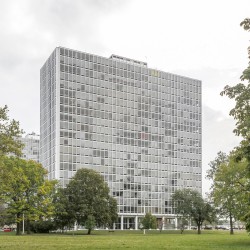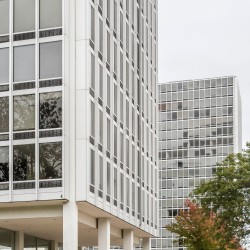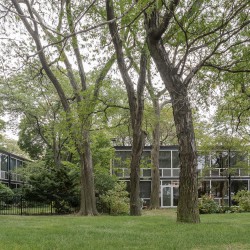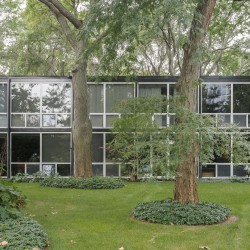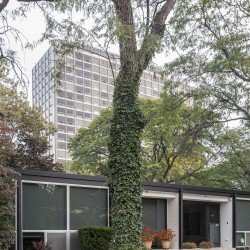Mies van der Rohe . photos: © Fernando Schapochnik
Lafayette Park shot by Fernando Schapochnik.
_
Lafayette Park is the outcome of an urban renewal effort that began in 1946. The city of Detroit developed a plan to acquire and clear the land and resell it to developers who would build low- and middle-income housing. However, the city’s proposal failed to attract developers and the land lay vacant for years.
In 1954, at the urging of Walter Reuther, then president of the UAW, the city turned the project over to a citizens’ committee. Composed of representatives from commerce, labor, and industry, the Citizen’s Redevelopment Corporation was determined to create a residential community of the highest design and construction standards. The committee wanted to avoid piecemeal development so it selected Herbert Greenwald, a Chicago real estate financier, to take on the entire project.
Greenwald had already collaborated on several successful high-rise projects in Chicago with the German-born architect, Ludwig Mies van der Rohe, and he put the world-renowned Mies in charge of Detroit’s redevelopment scheme. Together with his colleagues Ludwig Hilberseimer, city planner, and Alfred Caldwell, landscape architect, Mies created a plan for a traffic-free central park surrounded by low-and high-rise housing and various community amenities.
Sadly, Greenwald died in an airplane crash in 1959. The Pavilion Apartments had been finished in 1958, and construction of the townhouses began the same year. Lafayette Townhouses were completed first, followed by Nicolet, Joliet, and La Salle, which was finished in early 1960. After Greenwald’s death, the city of Detroit turned the rest of the project over to other developers and architects. The other structures, including sixteen low-rise buildings, five high-rises, school, community clubhouse and swimming pool, parking structures, and shopping center, envisioned by Mies were never built. The two Lafayette Towers, built in 1963, are the only other buildings in Lafayette Park of his design.
Although the project was never fully implemented, it is recognized as a triumph of urban planning.
On August 8, 1996, in recognition of its importance in the history of architecture and urban renewal, the 46-acre Mies van der Rohe Residential District, Lafayette Park was listed in the National Register of Historic Places by the United States Department of the Interior. The fiftieth anniversary of the groundbreaking at Lafayette Park was commemorated on October 16, 2006.
Text by Mies Detroit
https://www.miesdetroit.org/


